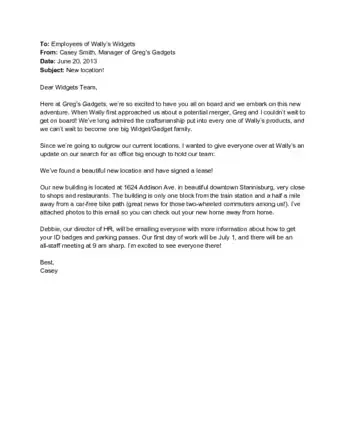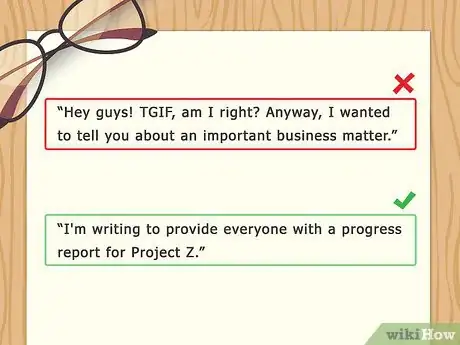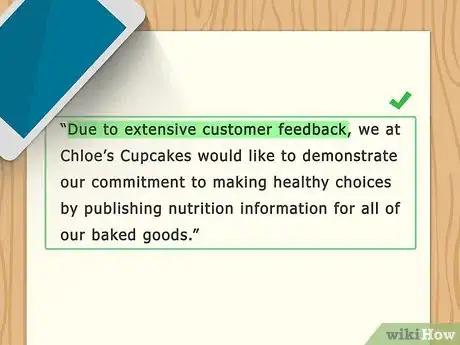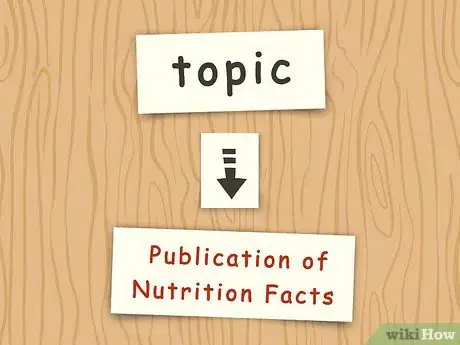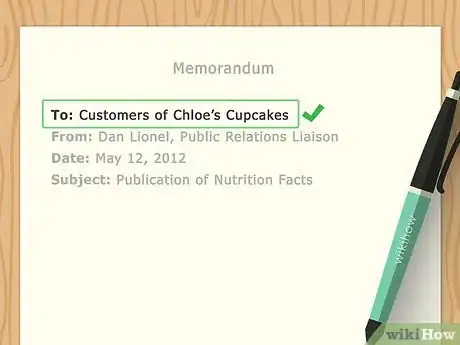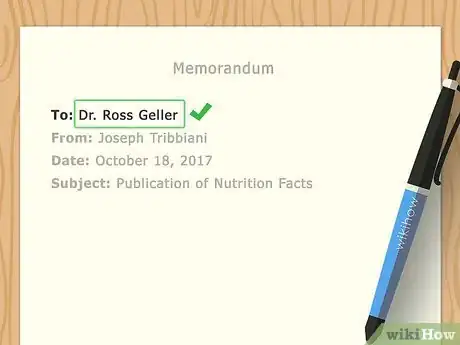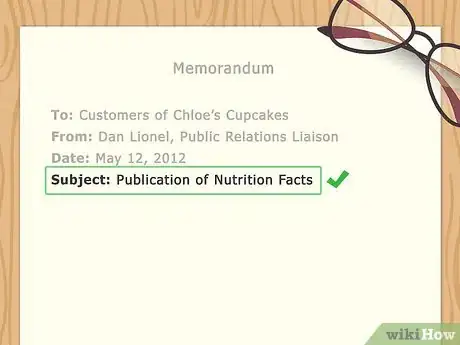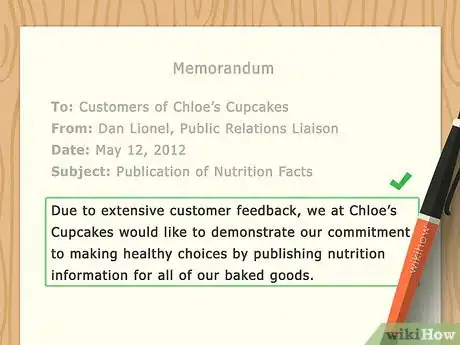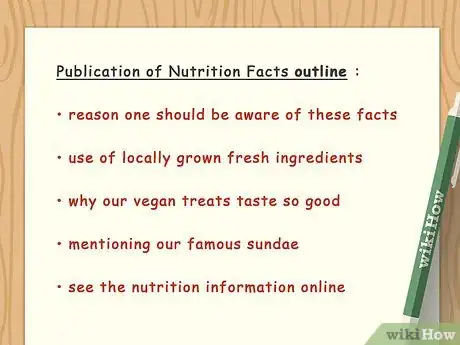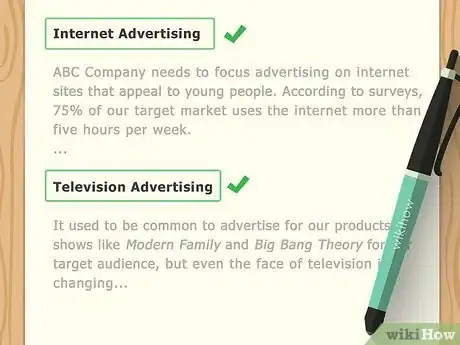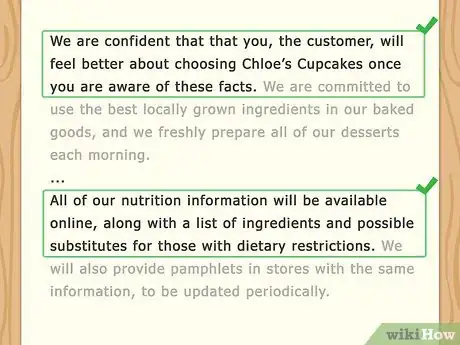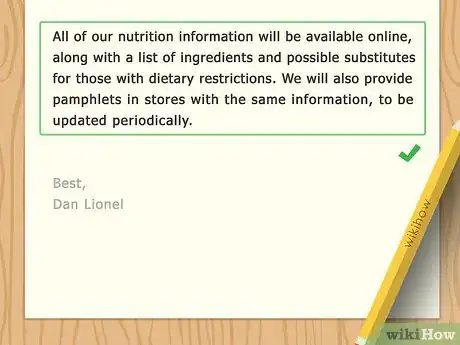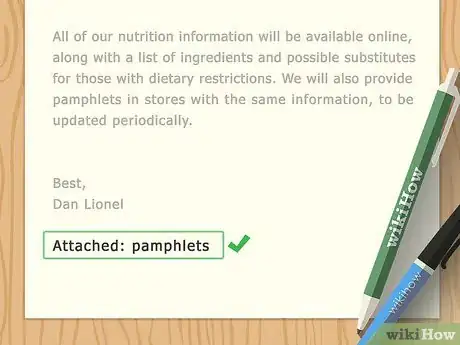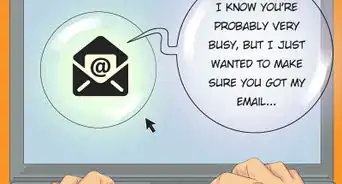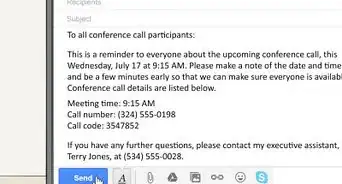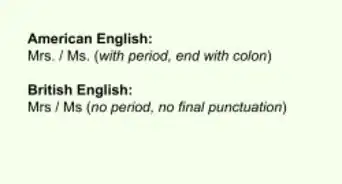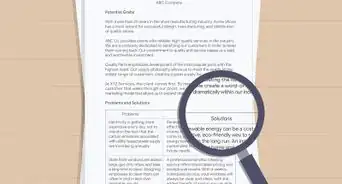wikiHow is a “wiki,” similar to Wikipedia, which means that many of our articles are co-written by multiple authors. To create this article, 28 people, some anonymous, worked to edit and improve it over time.
There are 7 references cited in this article, which can be found at the bottom of the page.
wikiHow marks an article as reader-approved once it receives enough positive feedback. This article has 20 testimonials from our readers, earning it our reader-approved status.
This article has been viewed 1,385,755 times.
Learn more...
A memorandum is a type of document used for internal communication between company employees. Memos are a time-tested aspect of the business world and, when written properly, help keep everything running smoothly.
Steps
Making Language and Formatting Choices
-
1Avoid language that is too casual. Generally speaking, your language should be straightforward and simple, yet professional. You should avoid taking too conversational of a tone in your memo, or else it won't sound as credible.[1]
- For example, avoid writing things like “Hey guys! TGIF, am I right? Anyway, I wanted to tell you about an important business matter.”
- Instead, get right to the point: “I'm writing to provide everyone with a progress report for Project Z”.
-
2Avoid using emotional language. It's also best to try to take a neutral tone when you write and avoid using emotionally-charged language. Do your best to refer to facts and evidence to support your claims.
- For example, avoid claims like “I think we'll all be so much happier if we're allowed to dress casually on Friday.”
- Instead, research to see if there are any studies on whether office morale increases when employees are allowed more autonomy in their choice of attire, and cite that in your memo.
Advertisement -
3Use signal phrases. When you are about to cite evidence or refer to a source, be sure to use language which lets the reader know what you're doing.[2]
- For example, try the following: “According to our findings,...” or “Research completed by the EPA has indicated that...”.
-
4Choose an appropriate font style and size. Your memo should be easy to read, so you should avoid using excessively small font—11 or 12 point is standard.[3]
- You should also choose a simple font style such as Times New Roman. This isn't the time to play around with “fun” fonts like Comic Sans (you'll be made fun of if you choose this one!).
-
5Use standard margins for your memo. 1-inch margins are typical for business memos, though some word-processing programs may include pre-formatted memo templates with slightly wider margins (for example, 1.25 inches).
-
6Single-space your document. Business memos are usually not double-spaced. In order to keep the page number down, consider single-spacing, but leave spaces between individual paragraphs or sections.[4]
- There is usually no need for you to indent your paragraphs.
Preparing to Write Your Business Memo
-
1Decide if a memo needs to be sent. If you need to update several people on your team about an important business matter, then sending a memo is an excellent idea. You may even want to send one if you're communicating with just one person if, for example, you want or need to have a written record of your correspondence.
- However, in some cases, it may be more efficient to just talk directly to those you need to.
- Also, some information may be too sensitive to send out in a memo.
-
2Identify your purpose for writing. Depending upon your specific purpose, the content and organization of your memo may change. Most types of memos are written for the following reasons:[5]
- To propose an idea or solution. For example, if you think you know how the scheduling problems for overtime can be worked out, you may want to write up your ideas in a memo, and send it to your superior(s).
- To issue an order. For example, sending a memo can be an efficient way to assign responsibilities for an upcoming conference that your department is hosting.
- To provide a report. You may also want to send a memo in order to update your colleagues about an event that's recently occurred, give an update on a project, provide a progress report, or report the findings of an investigation.
-
3Narrow your topic. You may be juggling a lot of projects and be tempted to send a memo updating your colleagues, superiors, or clients on everything you're currently working on. Keep in mind though, that business memos should clearly focus on just one issue.[6]
- They should be concise, clear, and easy to read quickly by busy individuals; thus, you don't want important information to be overlooked. Keeping the memo focused will help ensure that your message is received and understood.
-
4Consider your audience. The content, style and tone of your business memo will all be affected by the intended audience, so think carefully about everyone who will receive your memo.[7]
- For example, you'll write a different type of memo if you're writing to your colleagues about planning a surprise party for the people in the office with summer birthdays, as compared to when you're writing your supervisor about the results of your months-long investigation.
Composing Your Business Memo
-
1Label your memo. There are many different types of business correspondence. Standard practice for a memo is to explicitly title the document as such.[8]
- For example, type “Memo” or “Memorandum” at the top of the page.
- It's up to you as to whether you want to center or left-justify the title. A good rule of thumb is to examine the business memos you've received and copy the formatting.
-
2Write the heading of your memo. The first section of your memo should include four key pieces of information. We'll provide you with more detailed information about each component in later steps.[9]
- TO: provide the names and titles of everyone who will receive your memo.
- FROM: provide your complete name and title.
- DATE: provide the complete and accurate date—don't forget to include the year.
- SUBJECT: provide a brief, yet specific description of what the memo is about.
- Note that it's also common practice to indicate the subject line with “Re:” or “RE:” (both of which are short for regarding).
-
3Choose your recipient list carefully. Make sure that you include everyone who needs to be informed or updated. Limit the distribution of your memo to just those who need to know.
- It is poor business practice to send your memo office-wide if only a few are concerned or affected.
- People will quickly become overwhelmed by the sheer volume of memos, and may be more prone to ignore them or not read them carefully.
-
4Use the appropriate names and titles for the people on your recipient list. Even if you're on a friendly first-name basis with your boss, it's best to keep your written correspondence more formal. For example, you may call her “Sue” when you meet in the hall, but for the purposes of your memo, address her as “Ms. Wells” or “Dr. Wells”.[10]
- Keep this in mind when you're filling out the information for everyone on the recipient list: include full names and business titles.
-
5Research the proper titles of people you are writing to in an external memo. If you are sending a memo to someone outside of your office, it's also important to determine the proper form of address. Take the time to research their profile; their information is probably outlined on their company's website.[11]
- For example, do they have a PhD? If so, it's generally a good idea to refer to them as Dr. So-and-So.
- What is their title? For example, are they a vice president or a dean? If so, be sure to refer them as such in your memo.
-
6Compose the subject line carefully. You want to be sure that your subject line, while short, is clear and not too general.[12]
- For example, “New Business” is pretty vague, and if someone is searching through their files a few weeks or days down the road, they may have a hard time pinpointing your memo.
- Something better would be “Progress Report on Investigation for Expanding Customer Base”.
-
7Consider skipping the salutation. It's up to you whether you want to preface your message with a salutation like “Dear Ms. Winters,” or “Dear Colleagues”. Keep in mind though, that these greetings are not expected in a business memo.[13]
- This is meant to be a quick and efficient means of communicating important information, and it should be clear to your audience who is receiving the memo and who it is from.
-
8Compose the first, introductory section of the memo. Clearly state your purpose for writing and sending the memo.
- For example, “I am writing because...”. The introduction should provide a brief overview of what the recipients can expect in the memo.
-
9Keep the introductory section brief. There is no need to provide all of the details and/or evidence in the first section of your memo.
- Keep it on the shorter side—a few sentences or a short paragraph will suffice.
-
10Decide on the organization of the body of your memo. After the introduction, a business memo usually contains an additional two to four paragraphs before concluding. The content and organization will vary depending upon your topic.
- For example, you may choose to arrange the information in the body by order of importance, or if you are explaining a process, you will divide the body sections of your memo to correspond with the various stages of the process.
-
11Decide if you want to include subheadings and titles. Your business memo should have clear sections. It's common for business memos to be divided into clear sections so that the recipients can read and digest the information with ease. You may further help them grasp the important points of your memo by labeling the subsections.
-
12Write specific subheading titles. Make sure that the focus of each subsection is clear to your audience.
- For example, you might include all of the following subsections when writing about the office's impending move: “New Location For our Head Office,” “Important Directives for Packing the Office,” and “Timeline for Completion of the Office Move.”
-
13Include topic sentences in each of the body paragraphs of your memo. The first sentence of each subsection or paragraph should tell the audience what the main point of that section will be.
- The individual paragraphs or sections of your memo should be focused on just one idea.
-
14Consider using bullet points. You may find it helpful to use bullet points or create lists if you want to highlight important points. This can help your readers zero in on the key points and help them be able to read the memo more quickly and efficiently.[14]
-
15Keep it concise. Typically, a business memo should be no longer than one to two pages.
- This standard page limit is for a single-spaced document with spaces between sections.
-
16Decide if you need a summary paragraph. Generally speaking, you won't need to summarize what you've just written in your memo, especially if you managed to keep it under a page.[15]
- However, if the information you outlined was complicated, or if you sent a longer-than-normal memo, it may be helpful for you to briefly sum up the key points.
-
17Include a closing section or paragraph. Even if you judge that it's not necessary to summarize the memo, you still need to end it on a concluding note. Think about the following:
- What is the take away from the memo? Do you need the recipients to do anything? Should they respond by a certain day? If so, clearly state it.
- If no further action is required, include a simple closing sentiment such as “I'm happy to discuss this further” or “Let me know if you have any questions or concerns”.
-
18Sign if you wish. It's generally not necessary to add your complete name or signature at the end of your memo. Keep in mind, though, that it's safest to follow the example of others in your field.[16]
- If they sign formally (for example, “Regards, Ms. Smith), then follow suit.
- Even if you skip the signature, you may want to include your initials at the end of the document.
-
19Make a note about any attachments. If you included any attachments with your memo, such as tables, graphs, or reports, be sure to make a note of this at the end of your memo. For example, “Attached: Table 1”.[17]
- You should also refer to the attachments in the body of the memo as well.
- For example, if you are writing to let your employees know about an upcoming office move, you may write something like the following: “We intend to be finished with the moving process by the end of the quarter. See the attached Table 1 for a more detailed schedule.”
-
20Review the memo carefully. Prior to sending the memo, be sure to carefully proofread. Verify that your sentences are grammatically correct, that there are no spelling or punctuation errors, and that the content makes sense.
- Consider holding off on sending it after your initial proofread if it is not time-sensitive. If you review the memo again after an hour or two, you may find mistakes that you initially overlooked.
- If the memo contains sensitive information, check your company policy to see who can review the memo for you and give you final approval on the content.
Community Q&A
-
QuestionHow do I format a memo to include to and from information?
 Community AnswerIn the top left corner, put To: with the recipient's name. Put your information directly below it.
Community AnswerIn the top left corner, put To: with the recipient's name. Put your information directly below it. -
QuestionCan a memo contain one paragraph?
 Community AnswerYes, that is fine as long as all of the necessary information has been included in your paragraph.
Community AnswerYes, that is fine as long as all of the necessary information has been included in your paragraph. -
QuestionCan a business memo be handwritten?
 Community AnswerYes, but it's not recommended. It's unprofessional and people might not understand your handwriting.
Community AnswerYes, but it's not recommended. It's unprofessional and people might not understand your handwriting.
References
- ↑ https://www.grammarly.com/business/learn/how-to-write-business-memo/
- ↑ https://owl.purdue.edu/owl/research_and_citation/using_research/quoting_paraphrasing_and_summarizing/signal_and_lead_in_phrases.html
- ↑ https://writingcenter.uagc.edu/writing-business-memo
- ↑ https://writingcenter.uagc.edu/writing-business-memo
- ↑ https://www.indeed.com/career-advice/career-development/how-to-write-a-business-memo
- ↑ https://writingcenter.uagc.edu/writing-business-memo
- ↑ https://owl.purdue.edu/owl/subject_specific_writing/professional_technical_writing/memos/audience_and_purpose.html
- ↑ https://writingcenter.gmu.edu/writing-resources/different-genres/writing-business-memos
- ↑ https://edu.gcfglobal.org/en/business-communication/how-to-write-a-clear-business-memo/1/
- ↑ https://edu.gcfglobal.org/en/business-communication/how-to-write-a-clear-business-memo/1/
- ↑ https://edu.gcfglobal.org/en/business-communication/how-to-write-a-clear-business-memo/1/
- ↑ https://www.grammarly.com/business/learn/how-to-write-business-memo/
- ↑ https://writingcenter.uagc.edu/writing-business-memo
- ↑ https://www.grammarly.com/business/learn/how-to-write-business-memo/
- ↑ https://writingcenter.gmu.edu/writing-resources/different-genres/writing-business-memos
- ↑ https://writingcenter.uagc.edu/writing-business-memo
- ↑ https://www.indeed.com/career-advice/career-development/how-to-write-a-business-memo
About This Article
To write a memo, start by placing the word ‘Memorandum’ at the top of a page. Follow this up with a header that includes TO:, FROM:, DATE:, and SUBJECT: lines. When you’re ready to write, compose an intro paragraph stating the purpose of the memo, then add between 2 to 4 paragraphs of related information. If necessary, you can break up the text with bullet points or subheadings. To finish your letter, write a closing paragraph that tells readers if they need to take further action. For tips on structuring your memo and using effective language, read on!

